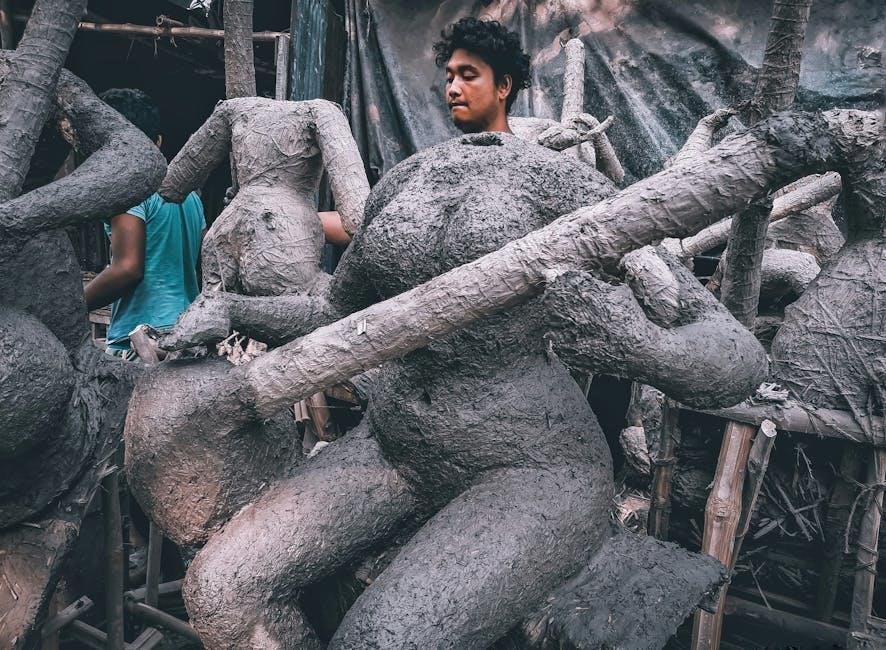the making of asian america pdf
The Making of Asian America: A History by Erika Lee explores the rich‚ complex narrative of Asian Americans‚ tracing their journeys from early immigrants to modern contributors‚ highlighting resilience‚ cultural blending‚ and the pursuit of equality in a diverse nation․
1․1 Overview of the Book and Its Author‚ Erika Lee
The Making of Asian America: A History‚ written by Erika Lee‚ is a comprehensive exploration of the Asian American experience․ Lee‚ a historian and professor at Harvard University‚ previously directed the Immigration History Research Center at the University of Minnesota․ Her work delves into the rich‚ often overlooked history of Asian immigrants and their descendants‚ from early arrivals to modern-day contributions․ The book spans centuries‚ highlighting resilience‚ cultural adaptation‚ and the struggles for equality․ It has been widely acclaimed for its detailed narrative and was a finalist for the 2015 Zócalo Book Prize‚ underscoring its significance in understanding Asian America’s complex identity․
1․2 The Significance of Asian American History in the U․S․
Asian American history is crucial for understanding the U․S․ as a nation of immigrants and its evolving identity․ It highlights the contributions of Asian immigrants and their descendants‚ who have shaped the country’s economic‚ cultural‚ and social landscapes․ From laborers building railroads to activists fighting for civil rights‚ their experiences reflect broader themes of resilience‚ exclusion‚ and integration․ Examining this history provides insight into the complexities of race‚ citizenship‚ and belonging‚ offering a nuanced perspective on America’s multicultural identity and the ongoing struggles for equality and representation․
1․3 Key Themes and Contributions of the Book
Erika Lee’s The Making of Asian America delves into themes of immigration‚ exclusion‚ and resilience‚ offering a comprehensive history of Asian Americans․ It challenges simplistic narratives by exploring the diverse experiences of various ethnic groups․ The book highlights contributions to U․S․ development‚ from labor in railroads to cultural influences․ Lee also examines the impact of policies like the 1965 Immigration Act and the struggles for civil rights․ By weaving personal stories with historical context‚ the book provides a vital perspective on identity‚ belonging‚ and the enduring legacy of Asian Americans in shaping the nation’s fabric․

Historical Overview of Asian Immigration to America
Asian immigration to America began in the 16th century‚ with waves driven by the Gold Rush and railroad labor‚ facing exclusion laws and resilience․
2․1 Early Waves of Asian Immigration (16th–19th Centuries)
The earliest Asian immigrants arrived in the Americas in the 16th century‚ with sailors and traders from present-day Philippines and China․ By the 19th century‚ large-scale immigration began‚ driven by economic opportunities like the Gold Rush and railroad construction․ Chinese immigrants‚ in particular‚ played a pivotal role in building U․S․ infrastructure‚ while Japanese and Indian laborers followed later․ These early waves laid the foundation for Asian American communities‚ despite facing significant challenges‚ including exclusion laws and racial discrimination‚ which would shape their experiences for generations to come․
2․2 The Impact of the Gold Rush and Railroad Construction
The Gold Rush of the mid-19th century drew thousands of Asian immigrants‚ particularly Chinese‚ to the U․S․ in search of economic opportunities․ Many found work in mining‚ while others turned to trades like laundry and restaurant services․ Simultaneously‚ the construction of the transcontinental railroad relied heavily on Chinese laborers‚ who endured hazardous conditions and low wages․ These industries became pivotal in shaping the U․S․ economy‚ with Asian immigrants playing a crucial role in their development․ Their contributions‚ however‚ were often overshadowed by rising anti-Asian sentiment and discriminatory policies․
2․3 Exclusion Laws and Their Effects on Asian Immigrants
The late 19th and early 20th centuries saw the enactment of exclusion laws targeting Asian immigrants‚ notably the Chinese Exclusion Act of 1882․ These laws severely restricted Asian immigration and denied naturalization rights‚ fueling anti-Asian sentiment․ Many Asian immigrants faced discrimination‚ violence‚ and limited economic opportunities‚ forcing them into segregated neighborhoods and jobs․ Despite these challenges‚ Asian communities persevered‚ building vibrant enclaves and advocating for their rights․ These exclusionary policies not only shaped the lives of Asian immigrants but also left a lasting impact on their identity and belonging in America․

The Role of Asian Americans in Shaping U․S․ Society
Asian Americans have significantly influenced the U․S․ through economic contributions‚ cultural enrichment‚ and civil rights advocacy‚ shaping the nation’s identity and fostering a more inclusive society․
3․1 Contributions to the Economic Development of the U․S․
Asian Americans have played a pivotal role in advancing the U․S․ economy through their labor‚ entrepreneurship‚ and innovation․ From early immigrants working in railroads and agriculture to modern-day professionals in tech and healthcare‚ their contributions have been transformative․ Many Asian Americans founded businesses‚ creating jobs and stimulating growth․ Their success in industries like technology‚ hospitality‚ and retail has further enriched the nation’s economic landscape․ By bringing diverse skills and global perspectives‚ Asian Americans have not only strengthened the economy but also inspired future generations to pursue opportunities in various sectors‚ fostering a culture of prosperity and inclusivity․ Their impact endures as a testament to resilience and achievement․
3․2 Cultural and Social Influences of Asian Americans
Asian Americans have profoundly enriched U․S․ culture and society through their traditions‚ art‚ cuisine‚ and values․ Their influence is evident in the popularity of Asian cuisine‚ festivals‚ and cultural practices that have become integral to American life․ Asian American artists‚ writers‚ and musicians have reshaped the cultural landscape‚ offering diverse perspectives and challenging stereotypes․ Moreover‚ their contributions to education‚ community building‚ and social justice movements have fostered inclusivity and understanding․ By bridging cultural gaps and promoting diversity‚ Asian Americans have created a more vibrant and interconnected society‚ leaving a lasting legacy in the fabric of American culture․
3․3 The Struggle for Civil Rights and Equality
Asian Americans have faced significant barriers in their pursuit of civil rights and equality‚ from exclusion laws to racial discrimination․ The incarceration of Japanese Americans during World War II and the struggles of other Asian groups highlight the systemic injustices they endured․ However‚ Asian Americans have actively challenged these inequalities through activism‚ legal battles‚ and advocacy․ Landmark legislation‚ such as the 1965 Immigration Act and the Civil Rights Act of 1964‚ marked turning points in their fight for justice․ Today‚ Asian Americans continue to advocate for equity‚ challenging stereotypes and pushing for representation in all aspects of American life․

The Making of Asian America Through Immigration Policy
Immigration policies have profoundly shaped the Asian American experience‚ from exclusionary laws to the landmark 1965 Immigration Act‚ influencing demographic shifts and opportunities for Asian Americans․
4․1 The Evolution of U․S․ Immigration Laws
The evolution of U․S․ immigration laws has significantly shaped the Asian American experience․ From the Chinese Exclusion Act of 1882 to the 1965 Immigration Act‚ these policies have dictated who could enter the country and under what conditions․ Early laws often targeted Asian immigrants‚ restricting their entry and citizenship rights․ However‚ the 1965 Act abolished race-based quotas‚ opening doors to immigrants from Asia and fostering demographic shifts․ These legal changes have profoundly influenced Asian American history‚ creating opportunities for growth while also reflecting broader societal attitudes toward race and immigration․
4․2 The Impact of the 1965 Immigration Act
The 1965 Immigration Act revolutionized Asian American history by abolishing race-based quotas‚ leading to a surge in immigration from Asia․ This policy shift opened doors for individuals from countries like China‚ India‚ and the Philippines‚ reshaping the demographic landscape of the U․S․ The act not only increased diversity but also spurred economic growth and cultural exchange․ It marked a turning point‚ enabling Asian immigrants to contribute significantly to American society while navigating challenges of integration and identity․ The act’s legacy is evident in the vibrant‚ diverse communities that define modern Asian America․
4․3 Contemporary Immigration Issues and Their Effects
Contemporary immigration issues deeply impact Asian American communities‚ with debates over policy reforms‚ visa backlogs‚ and pathways to citizenship․ The rise of anti-Asian sentiment‚ fueled by political rhetoric and global crises‚ has intensified challenges․ Many Asian immigrants face detention‚ deportation‚ and family separation‚ while others navigate complex systems for legal status․ These issues underscore systemic inequalities and barriers to integration․ Meanwhile‚ the contributions of Asian immigrants continue to shape the U․S․ economy and culture‚ highlighting the need for equitable solutions to ensure their rights and dignity are upheld in a rapidly changing world․

The Diversity of Asian American Experiences
Asian American experiences vary widely‚ shaped by regional‚ ethnic‚ and socioeconomic differences‚ reflecting diverse cultural traditions‚ generational backgrounds‚ and contributions to the U․S․ identity․
5․1 Regional and Ethnic Variations Among Asian Americans
Asian Americans encompass a wide array of regional and ethnic groups‚ each with unique cultural practices‚ languages‚ and immigration histories․ From Chinese and Japanese to Koreans‚ Filipinos‚ Indians‚ and Southeast Asians‚ these communities reflect diverse origins and experiences․ Regional variations‚ such as differences between South Asian and East Asian cultures‚ further highlight the complexity of Asian American identity․ Ethnic variations also influence socio-economic profiles‚ educational attainment‚ and political engagement․ These distinctions underscore the importance of understanding Asian America as a multifaceted tapestry rather than a monolithic group․ Such variations enrich the cultural landscape while challenging stereotypes of homogeneity․

5․2 The Role of Gender and Class in Shaping Experiences
Gender and class have profoundly shaped the experiences of Asian Americans‚ influencing their opportunities‚ challenges‚ and social dynamics․ Women often faced dual discrimination based on race and gender‚ limiting their access to education and employment․ Class disparities further stratified communities‚ with wealthier individuals gaining greater access to resources and political influence․ These intersecting factors created diverse trajectories for individuals and families‚ highlighting the complexity of Asian American life․ By examining how gender and class intersect with race‚ we gain a deeper understanding of the varied experiences within Asian America‚ revealing both resilience and inequality․ These dynamics continue to evolve today․
5․3 The Impact of War and Displacement on Asian American Communities
Wars and displacement have profoundly shaped the experiences of Asian American communities‚ creating lasting social‚ cultural‚ and economic challenges․ Events like World War II led to the incarceration of Japanese Americans‚ while conflicts in Southeast Asia resulted in the displacement of Vietnamese‚ Cambodian‚ and Laotian refugees․ These upheavals disrupted families‚ livelihoods‚ and cultural ties‚ forcing communities to rebuild and adapt․ The legacy of war continues to influence identity‚ resilience‚ and the ongoing struggle for justice and belonging․ Understanding these histories is crucial to grasping the complexities of Asian American life and the enduring impact of global conflicts․

The Role of Education and Activism in Asian America
Education and activism have empowered Asian Americans to challenge inequities‚ advocate for rights‚ and preserve cultural heritage‚ fostering a legacy of resilience and social transformation․
6․1 The Rise of Asian American Studies as a Discipline
Asian American Studies emerged as a discipline in the 1960s and 1970s‚ driven by student-led movements demanding inclusive curricula and representation of marginalized voices․ This academic field challenges stereotypes and highlights the diverse experiences of Asian Americans‚ fostering critical dialogue on race‚ identity‚ and citizenship․ By integrating history‚ literature‚ and social sciences‚ it provides a holistic understanding of Asian American contributions and struggles‚ promoting cultural awareness and equity in education․ The discipline has grown significantly‚ with universities nationwide adopting courses that reflect the richness and complexity of Asian American life and legacy․

6․2 Key Figures and Movements in Asian American Activism
Asian American activism has been shaped by influential figures and movements that fought for justice and equality․ The Asian American Movement of the 1960s and 1970s emphasized identity‚ empowerment‚ and solidarity‚ addressing issues like racism and imperialism․ Key figures such as Grace Lee Boggs‚ Yuri Kochiyama‚ and Phil Yu have championed civil rights‚ labor rights‚ and cultural representation․ These leaders and movements have inspired collective action‚ fostering a sense of community and resilience․ Their efforts continue to influence contemporary activism‚ ensuring Asian American voices are heard in the struggle for social justice and equity․
6․3 The Importance of Political Participation and Representation
Political participation and representation are crucial for Asian Americans to shape policies affecting their communities․ Historically‚ Asian Americans faced exclusion laws and systemic marginalization‚ limiting their political voice․ Today‚ increased voter turnout and elected officials like Vice President Kamala Harris highlight progress․ Representation ensures issues like immigration reform‚ healthcare‚ and education are addressed․ Activism and civic engagement empower Asian Americans to challenge stereotypes and advocate for equity․ By participating in politics‚ they reclaim their narrative‚ fostering inclusivity and influencing policies that reflect their diverse experiences and contributions to American society․ Continued activism is vital for sustained representation and justice;

The Impact of Global Events on Asian America
Global events like World War II and the Vietnam War profoundly shaped Asian American experiences‚ influencing migration‚ identity‚ and societal perceptions‚ while globalization continues to reshape their roles․
7․1 The Effects of World War II on Asian American Communities
World War II profoundly impacted Asian American communities‚ particularly Japanese Americans‚ who faced forced relocation and incarceration in internment camps due to wartime hysteria and racial prejudice․ Korean and Chinese Americans also experienced heightened scrutiny‚ while Asian American soldiers served in the U․S․ military‚ highlighting their patriotism despite domestic discrimination․ The war reshaped Asian American identity‚ as individuals navigated loyalty‚ citizenship‚ and belonging amidst national turmoil‚ leaving lasting scars and challenges for generations to come․
7․2 The Vietnam War and Its Legacy for Asian Americans
The Vietnam War deeply impacted Asian American communities‚ fostering anti-war activism and solidarity among diverse groups․ Asian Americans played crucial roles in the anti-war movement‚ challenging U․S․ imperialism and racial injustice‚ which resonated with their own struggles for equality․ The war also led to a significant influx of Asian refugees‚ particularly from Vietnam‚ Cambodia‚ and Laos‚ reshaping the demographic landscape of Asian America․ This period marked a turning point in Asian American identity‚ as it highlighted their complex relationships with both their homelands and the United States․ The legacy of the war continues to influence Asian American political engagement and cultural narratives․
7․3 The Role of Globalization in Shaping Modern Asian America
Globalization has profoundly shaped modern Asian America‚ fostering transnational connections and cultural exchange․ It has led to increased migration‚ remittances‚ and the growth of diasporic communities‚ blurring boundaries between Asia and the U․S․ Economic opportunities and technological advancements have enabled Asian Americans to thrive in diverse industries‚ from tech to healthcare․ However‚ globalization also brings challenges‚ such as wage disparities and cultural assimilation pressures․ Despite these complexities‚ it has strengthened Asian Americans’ dual identity‚ allowing them to bridge cultures and contribute uniquely to both nations․
The Making of Asian America Through Literature and Media
Literature and media have played a crucial role in shaping Asian America‚ offering diverse representations and challenging stereotypes to foster a more inclusive cultural narrative․
8․1 Representation of Asian Americans in Literature
Asian American literature reflects the diverse experiences of resilience‚ cultural identity‚ and societal challenges faced by Asian immigrants and their descendants․ Through novels‚ memoirs‚ and essays‚ authors like Viet Nguyen and Erika Lee highlight the struggles of marginalization and the quest for belonging․ Literature serves as a powerful medium to challenge stereotypes and humanize Asian American stories‚ offering insights into their contributions to the cultural fabric of the United States․ By exploring themes of identity‚ displacement‚ and integration‚ these works provide a deeper understanding of the Asian American experience and its significance in shaping the nation’s history․
8․2 The Role of Media in Shaping Perceptions of Asian Americans
Media has played a significant role in shaping public perceptions of Asian Americans‚ often influencing societal attitudes and stereotypes․ Historically‚ Asian Americans have been portrayed in limited and stereotypical roles‚ such as the “model minority” or the “perpetual foreigner‚” which oversimplify their experiences․ However‚ in recent years‚ there has been a shift toward more authentic representation‚ with media platforms showcasing diverse stories and voices․ Despite progress‚ challenges remain‚ as stereotypes and underrepresentation persist in many areas․ Media continues to be a powerful tool in both reflecting and shaping the identity of Asian Americans․ Its impact is undeniable․
8․3 Breaking Stereotypes and Promoting Diversity
Literature and media have become powerful tools in challenging stereotypes and promoting diversity within Asian American communities․ By sharing authentic narratives‚ authors like Amy Tan and Viet Nguyen have offered complex portrayals of Asian American life‚ moving beyond simplistic stereotypes․ Contemporary media‚ such as TV shows and films‚ have also played a crucial role in showcasing diverse experiences․ These efforts not only educate audiences but also empower Asian Americans to reclaim their identities․ Breaking stereotypes requires ongoing representation and storytelling‚ fostering a more inclusive understanding of Asian America’s rich cultural tapestry․ This shift is vital for fostering equality and recognition․

The Future of Asian America
Asian America’s future promises growth‚ cultural influence‚ and evolving roles in shaping U․S․ society․ Demographic expansion and younger generations’ activism will drive change‚ addressing identity and belonging in a diverse nation․
9․1 Demographic Trends and Projections
Asian Americans are the fastest-growing racial group in the U․S․‚ with a 43% increase from 2000 to 2010․ Today‚ they make up 6% of the population‚ with projections suggesting continued growth․
Factors like immigration and high birth rates drive this trend‚ while regional and ethnic diversity within the community expands․
This growth underscores the increasing influence of Asian Americans in shaping cultural‚ economic‚ and political landscapes․
Projections highlight the potential for greater representation and contributions in the future․
9․2 The Role of Younger Generations in Shaping the Future
Younger Asian American generations are pivotal in shaping the future‚ bringing diverse perspectives and energies to societal challenges․ Born in an era of heightened racial awareness‚ they are increasingly engaged in education‚ advocacy‚ and politics․
Their experiences with identity‚ cultural blending‚ and social justice movements equip them to address systemic inequalities․
As they grow‚ their influence will expand‚ fostering inclusivity and innovation across sectors․
This demographic’s activism and leadership are poised to redefine Asian America’s role in the nation’s progress․
9․3 Challenges and Opportunities for Asian Americans
Asian Americans face challenges like racial stereotypes‚ discrimination‚ and socio-economic disparities‚ yet they also encounter opportunities for growth and influence․ The community’s diversity presents both obstacles and strengths‚ as varying backgrounds and experiences shape unique perspectives․
Opportunities arise in education‚ entrepreneurship‚ and cultural exchange‚ enabling Asian Americans to bridge gaps and foster innovation․
Despite historical and contemporary barriers‚ their resilience and contributions continue to transform the nation‚ paving the way for a more inclusive future․
This duality underscores the complex yet promising trajectory of Asian America․
The Making of Asian America concludes with reflections on the enduring legacy of Asian American contributions‚ emphasizing their resilience‚ cultural richness‚ and the ongoing pursuit of identity and belonging in a diverse nation․
10․1 Reflections on the Past and Present
The Making of Asian America offers a profound reflection on the past and present‚ highlighting the resilience and adaptability of Asian Americans․ From early immigrants to modern-day contributors‚ the book traces their journey‚ emphasizing their role in shaping the nation’s cultural‚ economic‚ and social fabric․ It underscores the challenges of exclusion‚ discrimination‚ and identity while celebrating their achievements․ The narrative bridges history and contemporary issues‚ revealing how Asian Americans continue to navigate the complexities of belonging․ This reflection underscores the enduring legacy of their contributions and the ongoing quest for equality in a diverse America․
10․2 The Continuous Struggle for Identity and Belonging
The Making of Asian America highlights the enduring struggle of Asian Americans to assert their identity and belong in a society often marked by exclusion and stereotypes․ From historical exclusion laws to modern-day challenges‚ the book reveals how Asian Americans have navigated racial barriers‚ cultural expectations‚ and societal biases․ Despite these obstacles‚ they have consistently contributed to the nation’s progress while claiming their rightful place in America․ The narrative underscores the resilience and adaptability of Asian Americans‚ emphasizing their ongoing journey to reconcile their heritage with the complexities of American life and identity․
10․3 The Enduring Legacy of Asian American Contributions
The Making of Asian America underscores the profound and lasting impact of Asian Americans on U․S․ society‚ culture‚ and economy․ From labor contributions in early industries to cultural enrichment through arts and literature‚ Asian Americans have left an indelible mark․ Their resilience in overcoming exclusion and discrimination has shaped civil rights advancements‚ inspiring future generations․ The book emphasizes how these contributions continue to influence contemporary America‚ fostering diversity and innovation․ Asian Americans’ legacy is a testament to their enduring spirit and their integral role in the nation’s progress and identity‚ ensuring their story remains central to American history․

